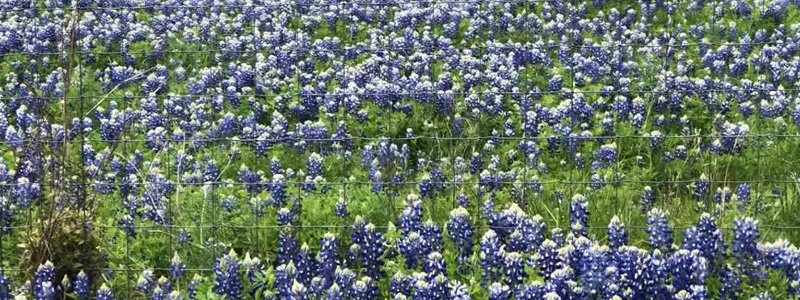Where to see Bluebonnets near Dallas
Motorists driving the Texas Bluebonnet country in spring are greeted with stunning fields of Bluebonnets and other wildflowers. Taking the time to leave the freeways and explore nearby back roads is even more rewarding.
Texas Bluebonnets
One of many lupines, the Bluebonnet (Lupinus subcarnosus) became the state flower in 1901. Seventy years later, this designation was expanded to include the Texas bluebonnet (Lupinus texensis) and “any other variety of bluebonnet.” Bluebonnets have also been called Buffalo clover, Wolf flower, and El Conejo (for the rabbit some see in the flower). It is thought that the bluebonnet name originated with early pioneers who saw a resemblance between the flower and women’s sunbonnets.
Bluebonnet Blooming Season
Bluebonnets begin blooming in the southern part of the range, in and around San Antonio, in March, and the bloom works it’s way north through May. The season’s peak varies with location, but around Ennis, Texas, it is thought to be April 21, coincidentally the anniversary of Texas’ independence from Mexico in 1836 (San Jacinto Day).
Bluebonnet Towns of Texas
Wildflower enthusiasts can find photogenic fields of flowers by taking almost any freeway exit when Bluebonnets are seen from the highway. A number of communities lying between Dallas and San Antonio publicize local events focused on the flowers, including Burnet and Ennis. Burnet was named the “Bluebonnet Capital of Texas” by the Legislature, and Ennis was designated the “Official Bluebonnet City of Texas.”
Burnet holds a Bluebonnet Festival the second weekend of April, and Ennis hosts a similar event, the Trails Festival, on the second or third weekend of April.
Backroad Bluebonnet Trails Around Ennis
Ennis publishes an area trails map, with detailed backroads around the town. You can obtain this in town from the Convention and Visitors Bureau, at 002 E. Ennis Avenue. The Visitors Bureau highlights the map each year, showing the most prime viewing areas for that year. The map includes about forty miles of backroads, from Exit 259 to Exit 251 off of Interstate 45.
Some of the more beautiful areas include the shores of Lake Bardwell, southwest of the town of Ennis, and the Neck Road–Highway 813/Highway 660 loop about eight miles north of Ennis.
The Greater Bluebonnet Area
The Central Texas Bluebonnet Travel Council publishes a travel guide for the greater Bluebonnet area, and this guide can be picked up at any Texas tourist center. The area covered by this guide runs from Dallas/Fort Worth on the north end through Austin to San Antonio on the southwest and to Houston on the southeast. Although Bluebonnets can be found in many places in the state, the best viewings will be found within this area, which includes Interstate highways 35, 45, and 10.
Bluebonnets and More
The Texas bluebonnet country offers much more than wildflowers, but if you are able to visit this area in the spring, the flowers likely will be your most vivid memory. Each spring, Texas wildflowers thrive along the highways between Dallas and San Antonio. The state flower, the Texas Bluebonnet, is the most spectacular and prolific.

